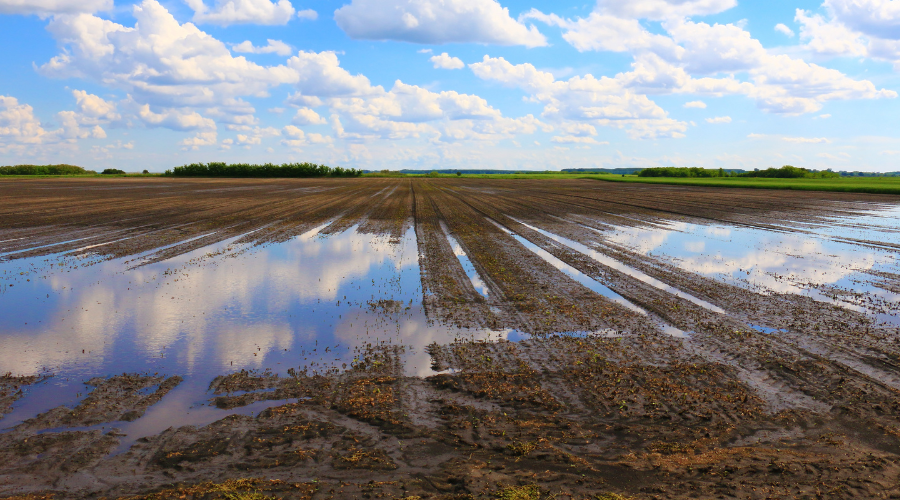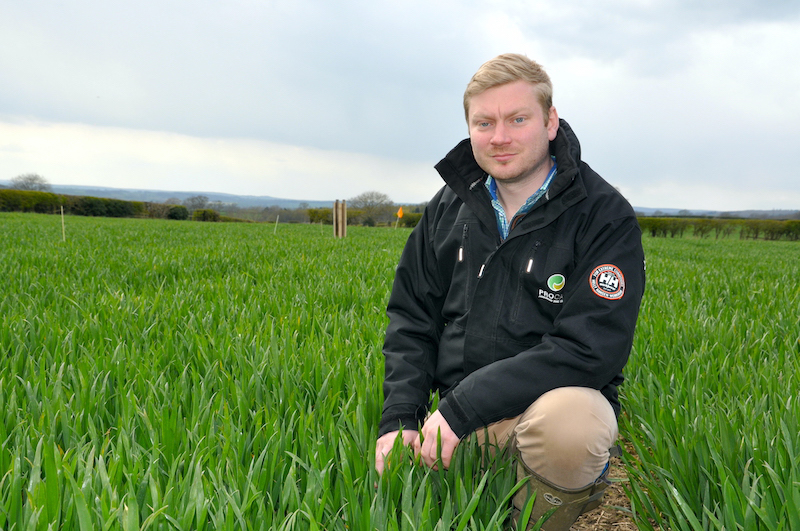Backward crops: What can farmers do to compensate for the wet winter?
16th January 2024
In light of the recent floods across the country, ProCam experts shared their views on what growers can do to compensate for the wet autumn and winter conditions, at a webinar in mid-January.

ProCam technical development manager Rob Adamson gave a national overview of the weather patterns towards the end of 2023.
October was incredibly wet across the UK, but November less so, which allowed some growers to drill during that short window – albeit into less-than-ideal conditions. This, however, is what has caught growers out, as above-average rainfall in December meant further rainfall hit already wet seedbeds – impacting these late-drilled crops.

He explained that there are three primary scenarios currently across the UK: 1) Those crops which have managed to establish over winter; 2) Crops that had been drilled but have flooded and failed, but where spring cropping hadn’t been planned for; and 3) Those farmers who were already planning to put spring crops in the ground, but may be facing constraints– particularly as the previous two scenarios will have an impact, primarily due to seed supply.
Lessons from last year
ProCam regional technical manager for the South and South Midlands, Paul Gruber stressed that while November may have had closer to average rainfall, there were only five dry days between 11th October and 21st November. Much of his area struggles with a high black-grass burden, so the majority of those growers, heeding good weed control advice, began drilling in October – giving them only a week or so of grace, before the wet weather closed in.
Mr Gruber explained that in some areas there are well-established crops, particularly where grassweed management has been good – the one positive of the wet weather being that it allowed residual herbicide chemistry to work well, unlike the previous year.

However, in contrast, there were also a lot of crops that got “muddled in” in poor conditions, with spray operators having been unable to get onto the ground to keep up with pre-emergence sprays – which has resulted in the worst-case scenario of poorly-established crops, which have received no herbicide yet.
So, Mr Gruber says, there are difficult decision to make, commenting: “Realistically, if you have a poorly established crop, with a sub-optimal plant population, and which is full of black-grass that you’re not expecting to be able to control – quite feasibly, you may have to write that crop off; although ensure you take a field-by-field approach when making this decision.
“If the black-grass is still relatively small, i.e. 2–3 leaves or less, it may be possible for a sprayer to get out on the ground, and put on residual chemistry which could have a reasonably good effect.”
He pointed out that plant population-wise, wheat will generally compensate fairly well, as long as you can get on early doors with feed; and the same for hybrid barley. He suggested the magic number would be 100 hybrid barley plants, or 80–100 wheat plants, which have the capacity to put yield on later in the season if they get enough nitrogen.
Looking at the forecast going forward, wet water-logged soils plus hard frosts mean there could be some frost lift, so Mr Gruber said one of the first jobs for the spring could be getting the rolls across the crops, as well as an early application of nitrogen.
For the better-established crops, particularly in the areas where grassweeds are less of a problem, there is quite a bit of disease pressure – especially from septoria.
He said: “Thinking back on how the disease progressed last season, after a very mild autumn, there was a lot of carry-over coming into the spring. To date, we’ve had a handful of frosts, but nothing terribly cold, and the cold weather hasn’t hung around too long.
“I can see a lot of those forward crops in the South West carrying a lot of disease into the spring. On that, we can learn a lot of lessons from last year. We need to hit these crops hard and early fungicide-wise if they are carrying a big burden of septoria, particularly in this part of the country.”
Mr Gruber also pointed out that there will be lower residual nitrogen in the ground, adding: “Likely around 40–60kg less than you’d ordinarily expect, if you consult RB209 under the high winter rainfall category. If your crop of wheat is sub-optimal and only likely to yield 7–8t/ha, there’s no point chucking high rates of nitrogen at it. But for potentially high-yielding crops, nitrogen remains the best ROI so underfeeding them could undo their potential.
Talking about preparations for spring cropping, Mr Gruber commented that the ground has dried out slightly of late, so if growers have winter wheat seed still in the shed, and they can catch it before the final vernalisation date, should the ground conditions allow in mid-late January, growers could continue with winter wheat drilling.
He added that winter beans could also be worth persevering with, particularly with the shortfall of spring seed – and advised growers to “crank up seed rates accordingly”.
In terms of planned traditional spring cropping, Mr Gruber said: “If the ground is a bit tender, experience tells us not to rush in. I know all the data will suggest fundamentally that earlier-drilled crops will probably perform better – but they will only perform better if they’re drilled into good conditions.
“Certainly, the earlier you can go, the better; but don’t go forcing it for the sake of a calendar date would be my best advice.”
Varied results
ProCam head of crop production covering the South coast and Eastern England, Mike Thornton, said that results in his area have been variable.
“Those across the south coast have been fairly lucky – some of the soils across this area are quite light, particularly across the chalk downland, so those crops went in in reasonably good time, with good drainage from the roots, so some of those have prospered.
“By and large, this area is growing quite a lot of quality wheats, including Group 2s such as Extase, as well as Zyatt and Skyfall. When one looks at the premium of those over feed, growers will want to look after them, so it’s full steam ahead.
“However, north of the M25, things have been more problematic. Farmers with particularly bad black-grass and ryegrass in particular delayed drilling as usual, and those who did eventually get their crops drilled have put some pretty hefty stacks of herbicide on the crops and then had a lot of rain, consistently. This hammered the crops pretty hard.

“Tank mixes of particular herbicides that, in previous years really hadn’t been a problem, this year have knocked crops much harder. I won’t say we’ve had any crops that have been completely destroyed; but there’s been this constant reactivation of chemicals.”
Mr Thornton pointed out that there have been short drainage windows, followed by rising water levels, and not having a significant number of dry days together has caused a big issue this year, due to lack of crop recovery – particularly for winter barley.
He added that it is very important for farmers to get started early with nitrogen applications in the spring to help the hybrid winter barley recover.
BYDV transmission in Sussex and Kent was high in 2022/23, and he can foresee this being a problem again this year – especially as some crops have had no aphicide at all so far this year, while others have already received two or, in some cases, three sprays – which is unprecedented.
Maximising farmers’ income
ProCam regional technical manager for Northern England, Nigel Scott, concluded the briefing by saying it is of key importance for farmers to stay calm and patiently work together with their agronomists to get the best results for their crops – rather than having a knee-jerk reaction.
He said: “It has to be a hand-in-hand approach to ultimately get the best out of these crops. At the end of the day, farming is a business, and farmers need to make money. It’s about profitability, especially in these times when the quantity price is not the highest. Also, the input prices have risen over the past 12–18 months, so it is important to maximise income.”

While on the whole, the wheat and barley crops in his area which were drilled in mid-September onwards seem to look well, Mr Scott warned that looks can be deceiving. In terms of growth above ground, they might appear well established and well-tillered; but the root systems may be compromised.
This is a challenge in itself, to maintain those tillers in order to achieve the maximum yield. Don’t be tempted to get the nitrogen out too early, as you already have enough stems – instead, increasing root mass of these forward crops should be the focus, so look at biostimulants, or phosphites, at your T0 or even earlier.
He reiterated his colleagues’ comments that septoria is a significant concern following the mild winter, with septoria being seen in pretty much all crops that were drilled earlier – the risk will ultimately be decided by what happens in the spring.
Read more arable news in our Arable hub.
